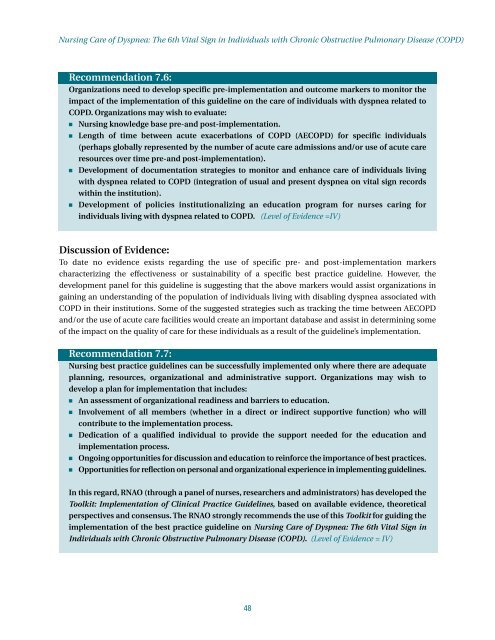Nursing Care of Dyspnea: The 6th Vital Sign in Individuals with ...
Nursing Care of Dyspnea: The 6th Vital Sign in Individuals with ...
Nursing Care of Dyspnea: The 6th Vital Sign in Individuals with ...
You also want an ePaper? Increase the reach of your titles
YUMPU automatically turns print PDFs into web optimized ePapers that Google loves.
<strong>Nurs<strong>in</strong>g</strong> <strong>Care</strong> <strong>of</strong> <strong>Dyspnea</strong>: <strong>The</strong> <strong>6th</strong> <strong>Vital</strong> <strong>Sign</strong> <strong>in</strong> <strong>Individuals</strong> <strong>with</strong> Chronic Obstructive Pulmonary Disease (COPD)Recommendation 7.6:Organizations need to develop specific pre-implementation and outcome markers to monitor theimpact <strong>of</strong> the implementation <strong>of</strong> this guidel<strong>in</strong>e on the care <strong>of</strong> <strong>in</strong>dividuals <strong>with</strong> dyspnea related toCOPD. Organizations may wish to evaluate:■ <strong>Nurs<strong>in</strong>g</strong> knowledge base pre-and post-implementation.■ Length <strong>of</strong> time between acute exacerbations <strong>of</strong> COPD (AECOPD) for specific <strong>in</strong>dividuals(perhaps globally represented by the number <strong>of</strong> acute care admissions and/or use <strong>of</strong> acute careresources over time pre-and post-implementation).■ Development <strong>of</strong> documentation strategies to monitor and enhance care <strong>of</strong> <strong>in</strong>dividuals liv<strong>in</strong>g<strong>with</strong> dyspnea related to COPD (<strong>in</strong>tegration <strong>of</strong> usual and present dyspnea on vital sign records<strong>with</strong><strong>in</strong> the <strong>in</strong>stitution).■ Development <strong>of</strong> policies <strong>in</strong>stitutionaliz<strong>in</strong>g an education program for nurses car<strong>in</strong>g for<strong>in</strong>dividuals liv<strong>in</strong>g <strong>with</strong> dyspnea related to COPD. (Level <strong>of</strong> Evidence =IV)Discussion <strong>of</strong> Evidence:To date no evidence exists regard<strong>in</strong>g the use <strong>of</strong> specific pre- and post-implementation markerscharacteriz<strong>in</strong>g the effectiveness or susta<strong>in</strong>ability <strong>of</strong> a specific best practice guidel<strong>in</strong>e. However, thedevelopment panel for this guidel<strong>in</strong>e is suggest<strong>in</strong>g that the above markers would assist organizations <strong>in</strong>ga<strong>in</strong><strong>in</strong>g an understand<strong>in</strong>g <strong>of</strong> the population <strong>of</strong> <strong>in</strong>dividuals liv<strong>in</strong>g <strong>with</strong> disabl<strong>in</strong>g dyspnea associated <strong>with</strong>COPD <strong>in</strong> their <strong>in</strong>stitutions. Some <strong>of</strong> the suggested strategies such as track<strong>in</strong>g the time between AECOPDand/or the use <strong>of</strong> acute care facilities would create an important database and assist <strong>in</strong> determ<strong>in</strong><strong>in</strong>g some<strong>of</strong> the impact on the quality <strong>of</strong> care for these <strong>in</strong>dividuals as a result <strong>of</strong> the guidel<strong>in</strong>e’s implementation.Recommendation 7.7:<strong>Nurs<strong>in</strong>g</strong> best practice guidel<strong>in</strong>es can be successfully implemented only where there are adequateplann<strong>in</strong>g, resources, organizational and adm<strong>in</strong>istrative support. Organizations may wish todevelop a plan for implementation that <strong>in</strong>cludes:■ An assessment <strong>of</strong> organizational read<strong>in</strong>ess and barriers to education.■ Involvement <strong>of</strong> all members (whether <strong>in</strong> a direct or <strong>in</strong>direct supportive function) who willcontribute to the implementation process.■ Dedication <strong>of</strong> a qualified <strong>in</strong>dividual to provide the support needed for the education andimplementation process.■ Ongo<strong>in</strong>g opportunities for discussion and education to re<strong>in</strong>force the importance <strong>of</strong> best practices.■ Opportunities for reflection on personal and organizational experience <strong>in</strong> implement<strong>in</strong>g guidel<strong>in</strong>es.In this regard, RNAO (through a panel <strong>of</strong> nurses, researchers and adm<strong>in</strong>istrators) has developed theToolkit: Implementation <strong>of</strong> Cl<strong>in</strong>ical Practice Guidel<strong>in</strong>es, based on available evidence, theoreticalperspectives and consensus. <strong>The</strong> RNAO strongly recommends the use <strong>of</strong> this Toolkit for guid<strong>in</strong>g theimplementation <strong>of</strong> the best practice guidel<strong>in</strong>e on <strong>Nurs<strong>in</strong>g</strong> <strong>Care</strong> <strong>of</strong> <strong>Dyspnea</strong>: <strong>The</strong> <strong>6th</strong> <strong>Vital</strong> <strong>Sign</strong> <strong>in</strong><strong>Individuals</strong> <strong>with</strong> Chronic Obstructive Pulmonary Disease (COPD). (Level <strong>of</strong> Evidence = IV)48
















